Cadbury Dairy Milk Tiffin Biscuit: HACCP Plan Report
VerifiedAdded on 2023/01/11
|10
|2603
|53
Report
AI Summary
This HACCP plan report meticulously analyzes the food safety risks associated with the production of Cadbury Dairy Milk Tiffin Biscuit. The report begins by outlining the HACCP team, describing the HACCP framework, and defining the scope and purpose of the plan, which is to identify and control potential hazards to comply with food safety standards. It details the product description, methods of distribution, and intended use, followed by a comprehensive overview of HACCP pre-requisites, including Good Manufacturing Practices (GMP), sanitation plans, pest control measures, facility requirements, equipment maintenance, staff training, and procedures for receiving and storing ingredients. The report also highlights the importance of document control, and references relevant literature and guidelines. The plan incorporates the Codex 7 principles to ensure compliance with Australian and New Zealand Food Standards Code, providing a robust framework for ensuring food safety throughout the production process. The report is a comprehensive guide to managing food safety risks.
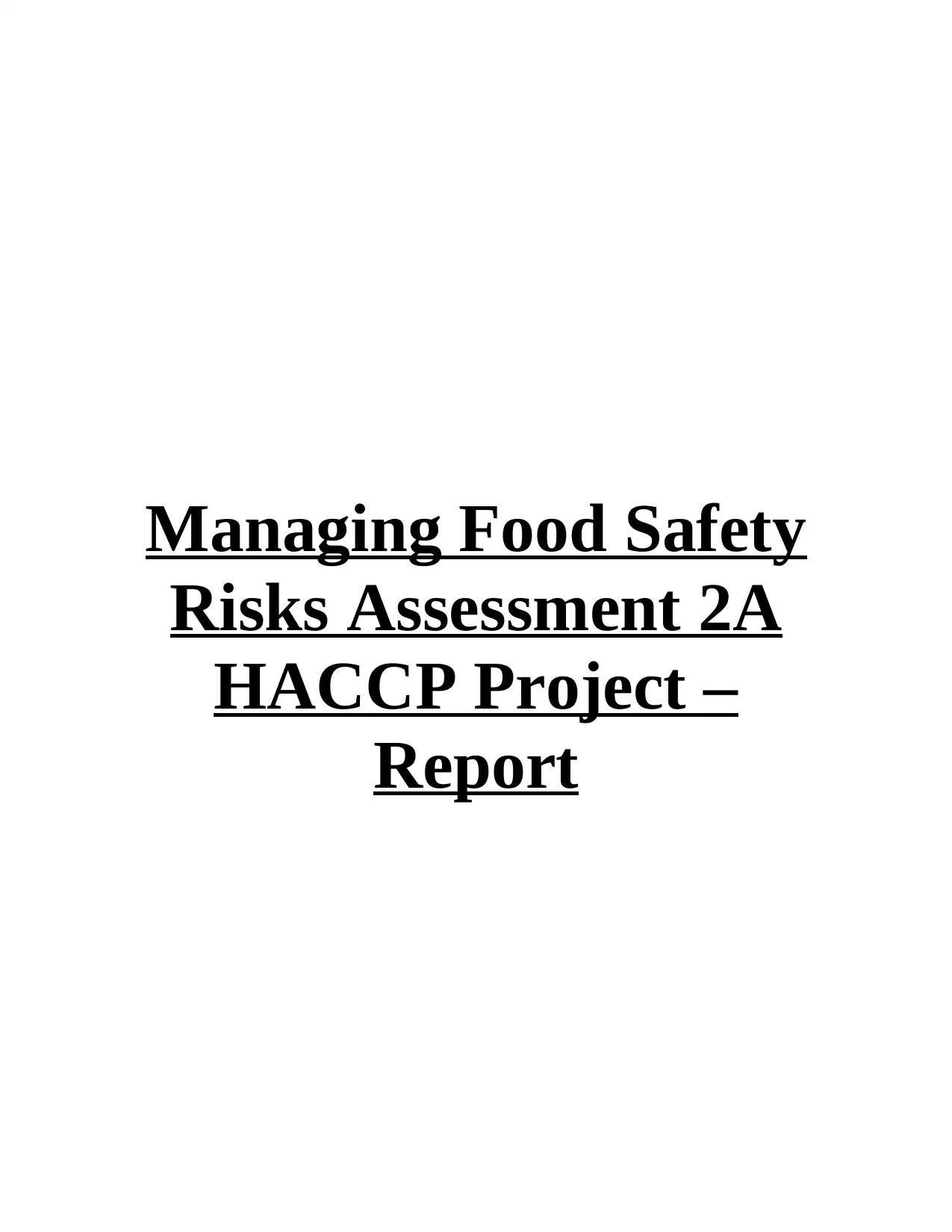
Managing Food Safety
Risks Assessment 2A
HACCP Project –
Report
Risks Assessment 2A
HACCP Project –
Report
Paraphrase This Document
Need a fresh take? Get an instant paraphrase of this document with our AI Paraphraser
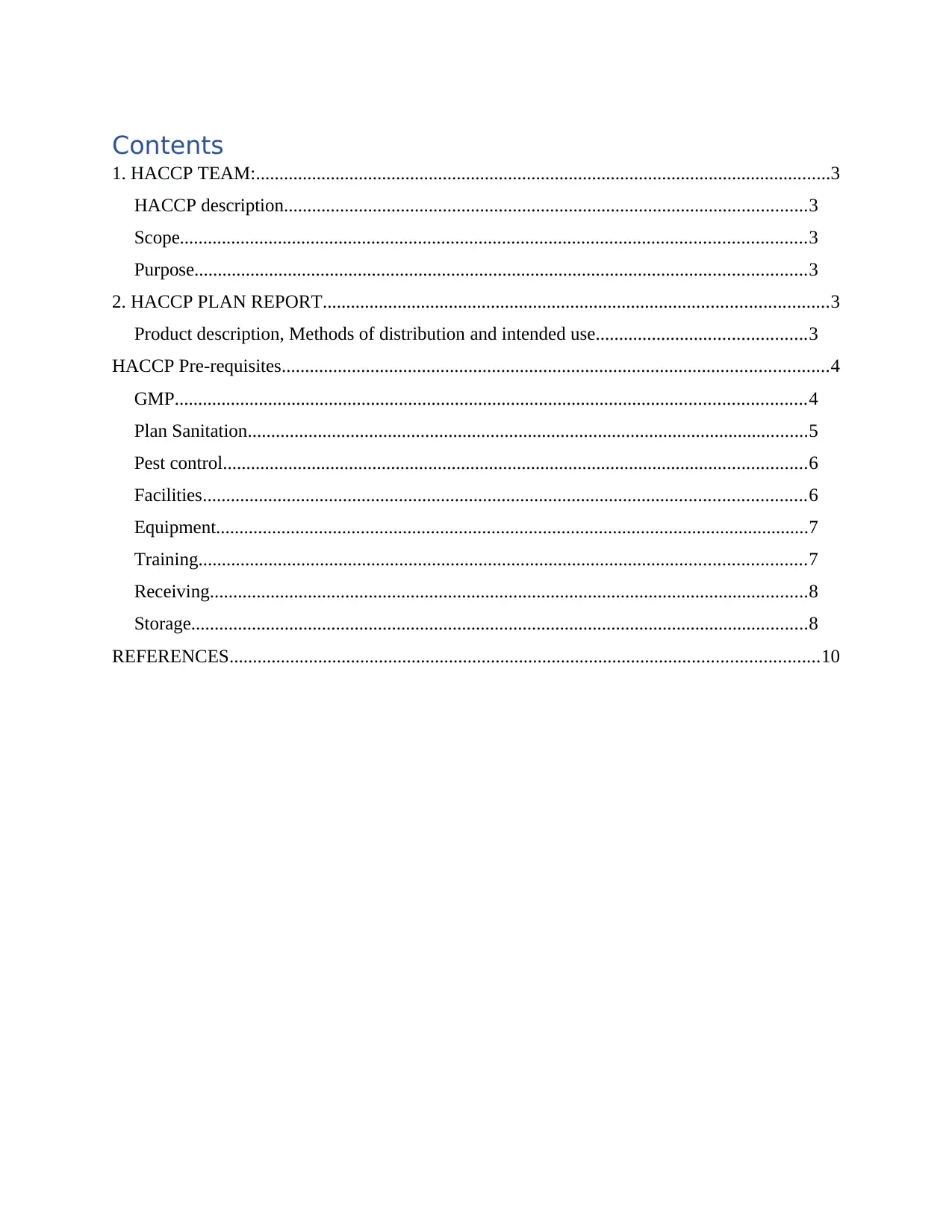
Contents
1. HACCP TEAM:...........................................................................................................................3
HACCP description................................................................................................................3
Scope......................................................................................................................................3
Purpose...................................................................................................................................3
2. HACCP PLAN REPORT............................................................................................................3
Product description, Methods of distribution and intended use.............................................3
HACCP Pre-requisites.....................................................................................................................4
GMP.......................................................................................................................................4
Plan Sanitation........................................................................................................................5
Pest control.............................................................................................................................6
Facilities.................................................................................................................................6
Equipment...............................................................................................................................7
Training..................................................................................................................................7
Receiving................................................................................................................................8
Storage....................................................................................................................................8
REFERENCES..............................................................................................................................10
1. HACCP TEAM:...........................................................................................................................3
HACCP description................................................................................................................3
Scope......................................................................................................................................3
Purpose...................................................................................................................................3
2. HACCP PLAN REPORT............................................................................................................3
Product description, Methods of distribution and intended use.............................................3
HACCP Pre-requisites.....................................................................................................................4
GMP.......................................................................................................................................4
Plan Sanitation........................................................................................................................5
Pest control.............................................................................................................................6
Facilities.................................................................................................................................6
Equipment...............................................................................................................................7
Training..................................................................................................................................7
Receiving................................................................................................................................8
Storage....................................................................................................................................8
REFERENCES..............................................................................................................................10
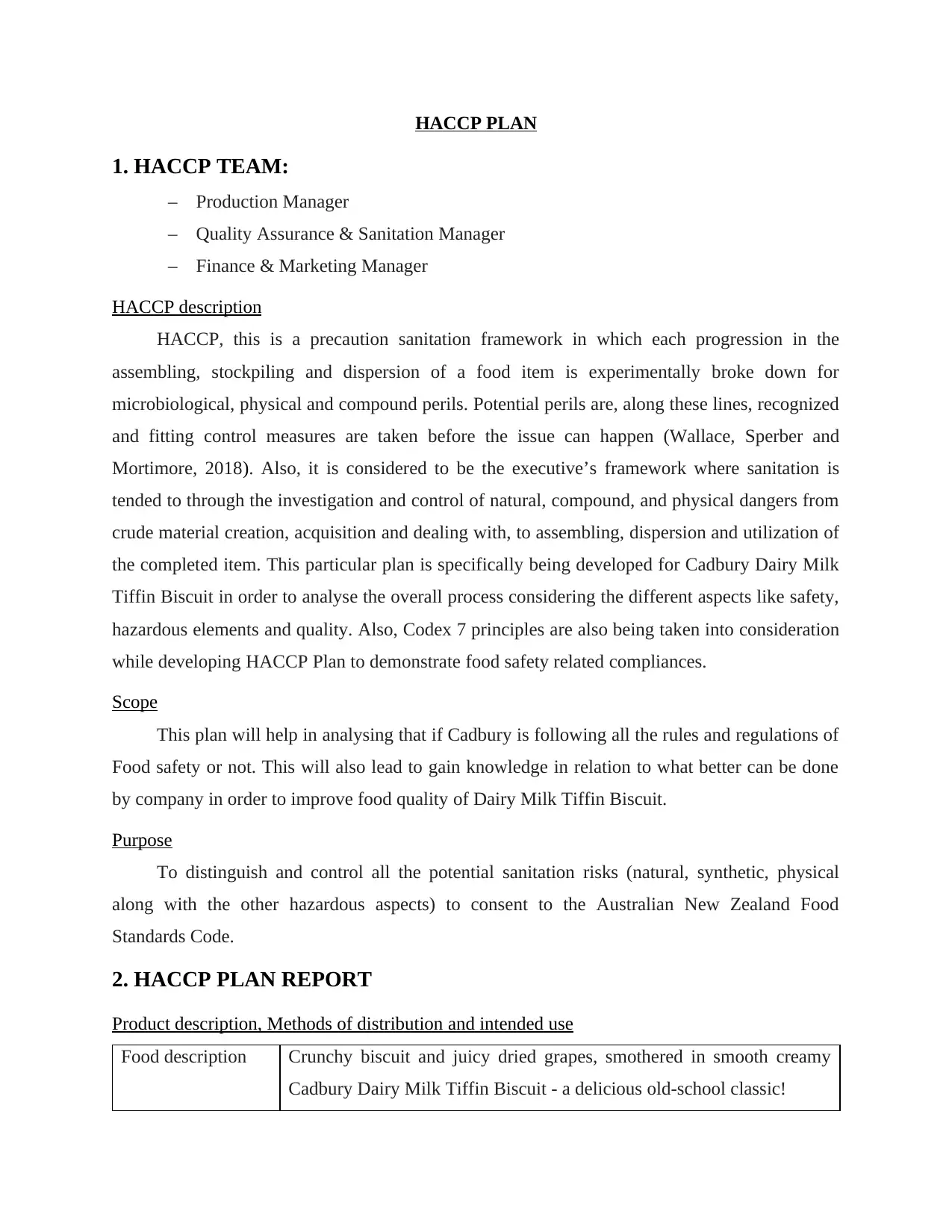
HACCP PLAN
1. HACCP TEAM:
– Production Manager
– Quality Assurance & Sanitation Manager
– Finance & Marketing Manager
HACCP description
HACCP, this is a precaution sanitation framework in which each progression in the
assembling, stockpiling and dispersion of a food item is experimentally broke down for
microbiological, physical and compound perils. Potential perils are, along these lines, recognized
and fitting control measures are taken before the issue can happen (Wallace, Sperber and
Mortimore, 2018). Also, it is considered to be the executive’s framework where sanitation is
tended to through the investigation and control of natural, compound, and physical dangers from
crude material creation, acquisition and dealing with, to assembling, dispersion and utilization of
the completed item. This particular plan is specifically being developed for Cadbury Dairy Milk
Tiffin Biscuit in order to analyse the overall process considering the different aspects like safety,
hazardous elements and quality. Also, Codex 7 principles are also being taken into consideration
while developing HACCP Plan to demonstrate food safety related compliances.
Scope
This plan will help in analysing that if Cadbury is following all the rules and regulations of
Food safety or not. This will also lead to gain knowledge in relation to what better can be done
by company in order to improve food quality of Dairy Milk Tiffin Biscuit.
Purpose
To distinguish and control all the potential sanitation risks (natural, synthetic, physical
along with the other hazardous aspects) to consent to the Australian New Zealand Food
Standards Code.
2. HACCP PLAN REPORT
Product description, Methods of distribution and intended use
Food description Crunchy biscuit and juicy dried grapes, smothered in smooth creamy
Cadbury Dairy Milk Tiffin Biscuit - a delicious old-school classic!
1. HACCP TEAM:
– Production Manager
– Quality Assurance & Sanitation Manager
– Finance & Marketing Manager
HACCP description
HACCP, this is a precaution sanitation framework in which each progression in the
assembling, stockpiling and dispersion of a food item is experimentally broke down for
microbiological, physical and compound perils. Potential perils are, along these lines, recognized
and fitting control measures are taken before the issue can happen (Wallace, Sperber and
Mortimore, 2018). Also, it is considered to be the executive’s framework where sanitation is
tended to through the investigation and control of natural, compound, and physical dangers from
crude material creation, acquisition and dealing with, to assembling, dispersion and utilization of
the completed item. This particular plan is specifically being developed for Cadbury Dairy Milk
Tiffin Biscuit in order to analyse the overall process considering the different aspects like safety,
hazardous elements and quality. Also, Codex 7 principles are also being taken into consideration
while developing HACCP Plan to demonstrate food safety related compliances.
Scope
This plan will help in analysing that if Cadbury is following all the rules and regulations of
Food safety or not. This will also lead to gain knowledge in relation to what better can be done
by company in order to improve food quality of Dairy Milk Tiffin Biscuit.
Purpose
To distinguish and control all the potential sanitation risks (natural, synthetic, physical
along with the other hazardous aspects) to consent to the Australian New Zealand Food
Standards Code.
2. HACCP PLAN REPORT
Product description, Methods of distribution and intended use
Food description Crunchy biscuit and juicy dried grapes, smothered in smooth creamy
Cadbury Dairy Milk Tiffin Biscuit - a delicious old-school classic!
⊘ This is a preview!⊘
Do you want full access?
Subscribe today to unlock all pages.

Trusted by 1+ million students worldwide
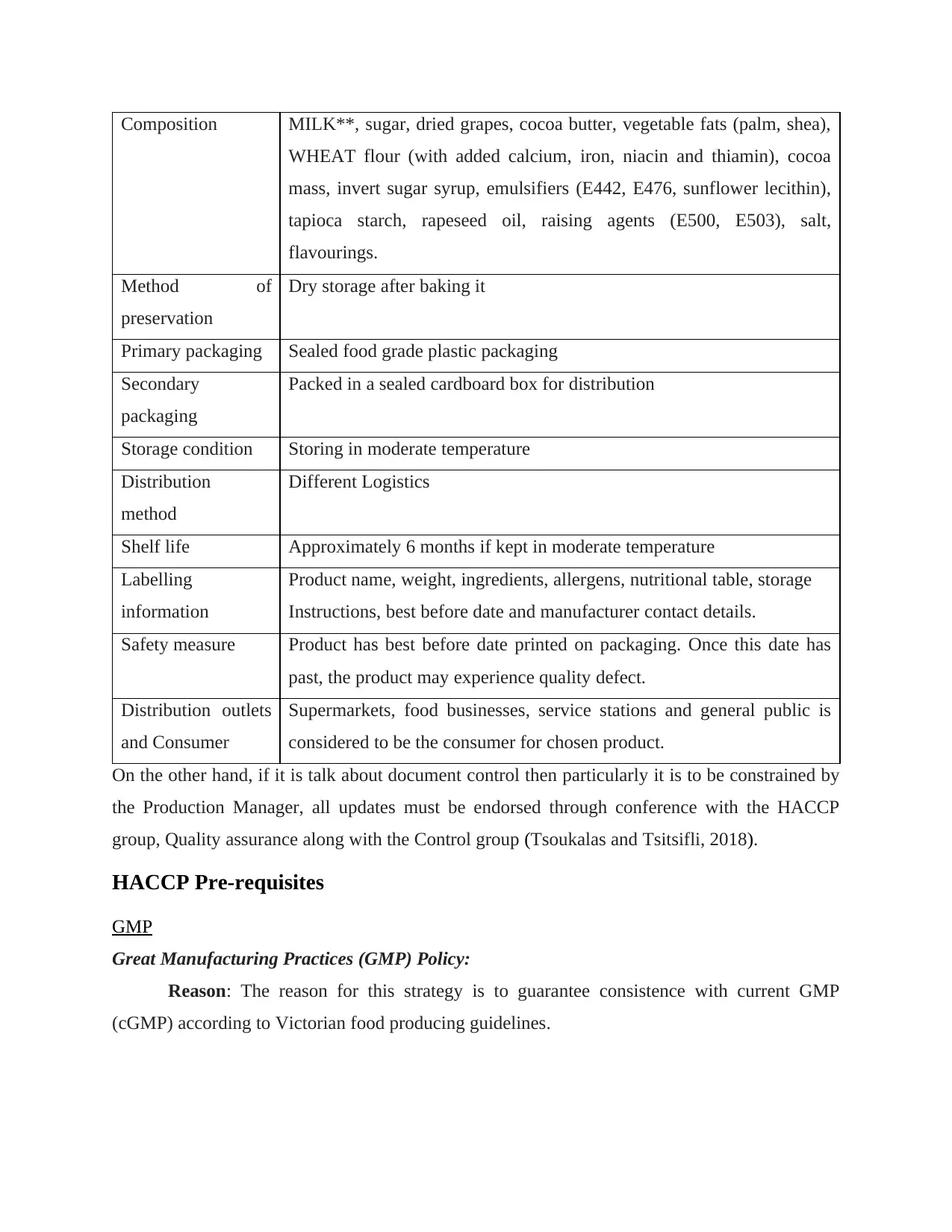
Composition MILK**, sugar, dried grapes, cocoa butter, vegetable fats (palm, shea),
WHEAT flour (with added calcium, iron, niacin and thiamin), cocoa
mass, invert sugar syrup, emulsifiers (E442, E476, sunflower lecithin),
tapioca starch, rapeseed oil, raising agents (E500, E503), salt,
flavourings.
Method of
preservation
Dry storage after baking it
Primary packaging Sealed food grade plastic packaging
Secondary
packaging
Packed in a sealed cardboard box for distribution
Storage condition Storing in moderate temperature
Distribution
method
Different Logistics
Shelf life Approximately 6 months if kept in moderate temperature
Labelling
information
Product name, weight, ingredients, allergens, nutritional table, storage
Instructions, best before date and manufacturer contact details.
Safety measure Product has best before date printed on packaging. Once this date has
past, the product may experience quality defect.
Distribution outlets
and Consumer
Supermarkets, food businesses, service stations and general public is
considered to be the consumer for chosen product.
On the other hand, if it is talk about document control then particularly it is to be constrained by
the Production Manager, all updates must be endorsed through conference with the HACCP
group, Quality assurance along with the Control group (Tsoukalas and Tsitsifli, 2018).
HACCP Pre-requisites
GMP
Great Manufacturing Practices (GMP) Policy:
Reason: The reason for this strategy is to guarantee consistence with current GMP
(cGMP) according to Victorian food producing guidelines.
WHEAT flour (with added calcium, iron, niacin and thiamin), cocoa
mass, invert sugar syrup, emulsifiers (E442, E476, sunflower lecithin),
tapioca starch, rapeseed oil, raising agents (E500, E503), salt,
flavourings.
Method of
preservation
Dry storage after baking it
Primary packaging Sealed food grade plastic packaging
Secondary
packaging
Packed in a sealed cardboard box for distribution
Storage condition Storing in moderate temperature
Distribution
method
Different Logistics
Shelf life Approximately 6 months if kept in moderate temperature
Labelling
information
Product name, weight, ingredients, allergens, nutritional table, storage
Instructions, best before date and manufacturer contact details.
Safety measure Product has best before date printed on packaging. Once this date has
past, the product may experience quality defect.
Distribution outlets
and Consumer
Supermarkets, food businesses, service stations and general public is
considered to be the consumer for chosen product.
On the other hand, if it is talk about document control then particularly it is to be constrained by
the Production Manager, all updates must be endorsed through conference with the HACCP
group, Quality assurance along with the Control group (Tsoukalas and Tsitsifli, 2018).
HACCP Pre-requisites
GMP
Great Manufacturing Practices (GMP) Policy:
Reason: The reason for this strategy is to guarantee consistence with current GMP
(cGMP) according to Victorian food producing guidelines.
Paraphrase This Document
Need a fresh take? Get an instant paraphrase of this document with our AI Paraphraser
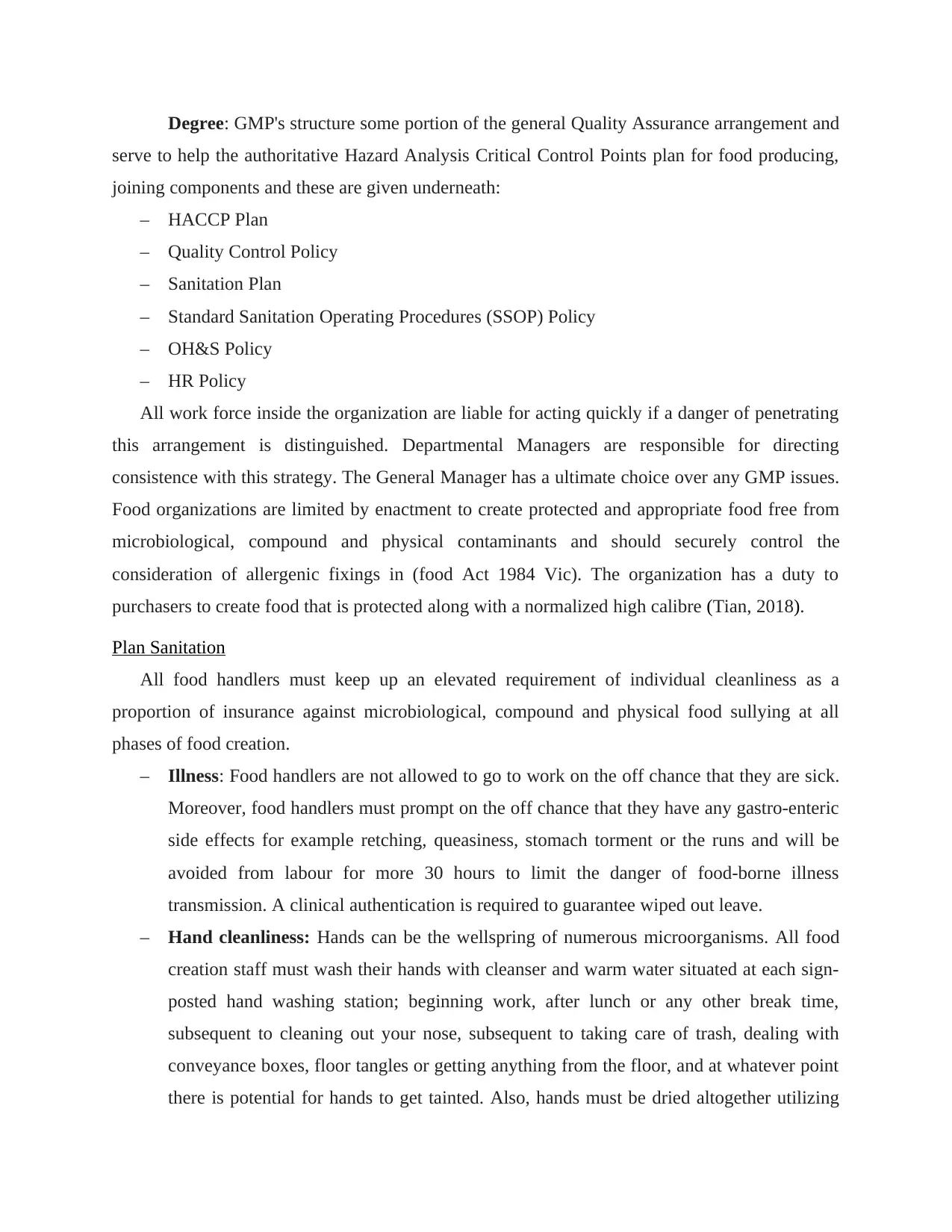
Degree: GMP's structure some portion of the general Quality Assurance arrangement and
serve to help the authoritative Hazard Analysis Critical Control Points plan for food producing,
joining components and these are given underneath:
– HACCP Plan
– Quality Control Policy
– Sanitation Plan
– Standard Sanitation Operating Procedures (SSOP) Policy
– OH&S Policy
– HR Policy
All work force inside the organization are liable for acting quickly if a danger of penetrating
this arrangement is distinguished. Departmental Managers are responsible for directing
consistence with this strategy. The General Manager has a ultimate choice over any GMP issues.
Food organizations are limited by enactment to create protected and appropriate food free from
microbiological, compound and physical contaminants and should securely control the
consideration of allergenic fixings in (food Act 1984 Vic). The organization has a duty to
purchasers to create food that is protected along with a normalized high calibre (Tian, 2018).
Plan Sanitation
All food handlers must keep up an elevated requirement of individual cleanliness as a
proportion of insurance against microbiological, compound and physical food sullying at all
phases of food creation.
– Illness: Food handlers are not allowed to go to work on the off chance that they are sick.
Moreover, food handlers must prompt on the off chance that they have any gastro-enteric
side effects for example retching, queasiness, stomach torment or the runs and will be
avoided from labour for more 30 hours to limit the danger of food-borne illness
transmission. A clinical authentication is required to guarantee wiped out leave.
– Hand cleanliness: Hands can be the wellspring of numerous microorganisms. All food
creation staff must wash their hands with cleanser and warm water situated at each sign-
posted hand washing station; beginning work, after lunch or any other break time,
subsequent to cleaning out your nose, subsequent to taking care of trash, dealing with
conveyance boxes, floor tangles or getting anything from the floor, and at whatever point
there is potential for hands to get tainted. Also, hands must be dried altogether utilizing
serve to help the authoritative Hazard Analysis Critical Control Points plan for food producing,
joining components and these are given underneath:
– HACCP Plan
– Quality Control Policy
– Sanitation Plan
– Standard Sanitation Operating Procedures (SSOP) Policy
– OH&S Policy
– HR Policy
All work force inside the organization are liable for acting quickly if a danger of penetrating
this arrangement is distinguished. Departmental Managers are responsible for directing
consistence with this strategy. The General Manager has a ultimate choice over any GMP issues.
Food organizations are limited by enactment to create protected and appropriate food free from
microbiological, compound and physical contaminants and should securely control the
consideration of allergenic fixings in (food Act 1984 Vic). The organization has a duty to
purchasers to create food that is protected along with a normalized high calibre (Tian, 2018).
Plan Sanitation
All food handlers must keep up an elevated requirement of individual cleanliness as a
proportion of insurance against microbiological, compound and physical food sullying at all
phases of food creation.
– Illness: Food handlers are not allowed to go to work on the off chance that they are sick.
Moreover, food handlers must prompt on the off chance that they have any gastro-enteric
side effects for example retching, queasiness, stomach torment or the runs and will be
avoided from labour for more 30 hours to limit the danger of food-borne illness
transmission. A clinical authentication is required to guarantee wiped out leave.
– Hand cleanliness: Hands can be the wellspring of numerous microorganisms. All food
creation staff must wash their hands with cleanser and warm water situated at each sign-
posted hand washing station; beginning work, after lunch or any other break time,
subsequent to cleaning out your nose, subsequent to taking care of trash, dealing with
conveyance boxes, floor tangles or getting anything from the floor, and at whatever point
there is potential for hands to get tainted. Also, hands must be dried altogether utilizing
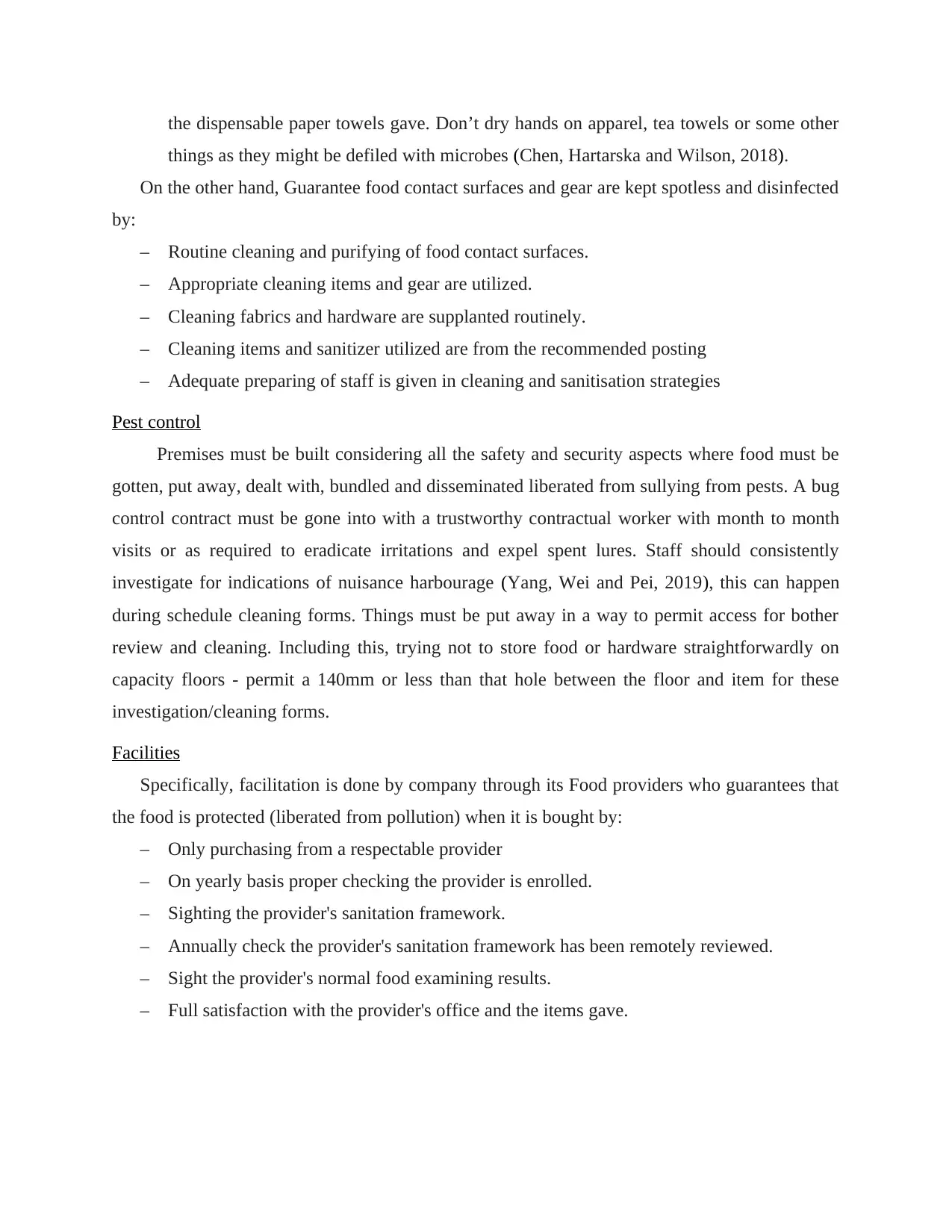
the dispensable paper towels gave. Don’t dry hands on apparel, tea towels or some other
things as they might be defiled with microbes (Chen, Hartarska and Wilson, 2018).
On the other hand, Guarantee food contact surfaces and gear are kept spotless and disinfected
by:
– Routine cleaning and purifying of food contact surfaces.
– Appropriate cleaning items and gear are utilized.
– Cleaning fabrics and hardware are supplanted routinely.
– Cleaning items and sanitizer utilized are from the recommended posting
– Adequate preparing of staff is given in cleaning and sanitisation strategies
Pest control
Premises must be built considering all the safety and security aspects where food must be
gotten, put away, dealt with, bundled and disseminated liberated from sullying from pests. A bug
control contract must be gone into with a trustworthy contractual worker with month to month
visits or as required to eradicate irritations and expel spent lures. Staff should consistently
investigate for indications of nuisance harbourage (Yang, Wei and Pei, 2019), this can happen
during schedule cleaning forms. Things must be put away in a way to permit access for bother
review and cleaning. Including this, trying not to store food or hardware straightforwardly on
capacity floors - permit a 140mm or less than that hole between the floor and item for these
investigation/cleaning forms.
Facilities
Specifically, facilitation is done by company through its Food providers who guarantees that
the food is protected (liberated from pollution) when it is bought by:
– Only purchasing from a respectable provider
– On yearly basis proper checking the provider is enrolled.
– Sighting the provider's sanitation framework.
– Annually check the provider's sanitation framework has been remotely reviewed.
– Sight the provider's normal food examining results.
– Full satisfaction with the provider's office and the items gave.
things as they might be defiled with microbes (Chen, Hartarska and Wilson, 2018).
On the other hand, Guarantee food contact surfaces and gear are kept spotless and disinfected
by:
– Routine cleaning and purifying of food contact surfaces.
– Appropriate cleaning items and gear are utilized.
– Cleaning fabrics and hardware are supplanted routinely.
– Cleaning items and sanitizer utilized are from the recommended posting
– Adequate preparing of staff is given in cleaning and sanitisation strategies
Pest control
Premises must be built considering all the safety and security aspects where food must be
gotten, put away, dealt with, bundled and disseminated liberated from sullying from pests. A bug
control contract must be gone into with a trustworthy contractual worker with month to month
visits or as required to eradicate irritations and expel spent lures. Staff should consistently
investigate for indications of nuisance harbourage (Yang, Wei and Pei, 2019), this can happen
during schedule cleaning forms. Things must be put away in a way to permit access for bother
review and cleaning. Including this, trying not to store food or hardware straightforwardly on
capacity floors - permit a 140mm or less than that hole between the floor and item for these
investigation/cleaning forms.
Facilities
Specifically, facilitation is done by company through its Food providers who guarantees that
the food is protected (liberated from pollution) when it is bought by:
– Only purchasing from a respectable provider
– On yearly basis proper checking the provider is enrolled.
– Sighting the provider's sanitation framework.
– Annually check the provider's sanitation framework has been remotely reviewed.
– Sight the provider's normal food examining results.
– Full satisfaction with the provider's office and the items gave.
⊘ This is a preview!⊘
Do you want full access?
Subscribe today to unlock all pages.

Trusted by 1+ million students worldwide
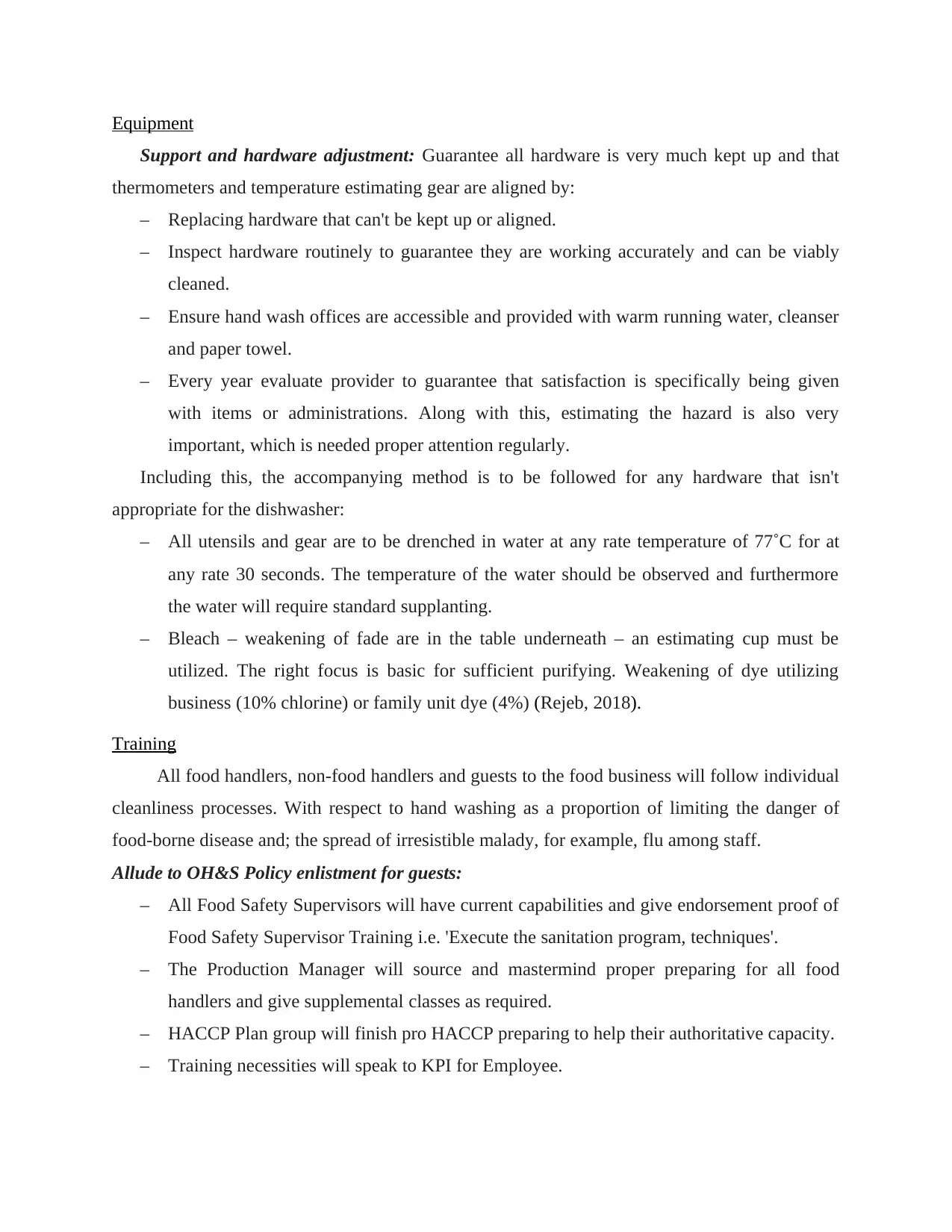
Equipment
Support and hardware adjustment: Guarantee all hardware is very much kept up and that
thermometers and temperature estimating gear are aligned by:
– Replacing hardware that can't be kept up or aligned.
– Inspect hardware routinely to guarantee they are working accurately and can be viably
cleaned.
– Ensure hand wash offices are accessible and provided with warm running water, cleanser
and paper towel.
– Every year evaluate provider to guarantee that satisfaction is specifically being given
with items or administrations. Along with this, estimating the hazard is also very
important, which is needed proper attention regularly.
Including this, the accompanying method is to be followed for any hardware that isn't
appropriate for the dishwasher:
– All utensils and gear are to be drenched in water at any rate temperature of 77˚C for at
any rate 30 seconds. The temperature of the water should be observed and furthermore
the water will require standard supplanting.
– Bleach – weakening of fade are in the table underneath – an estimating cup must be
utilized. The right focus is basic for sufficient purifying. Weakening of dye utilizing
business (10% chlorine) or family unit dye (4%) (Rejeb, 2018).
Training
All food handlers, non-food handlers and guests to the food business will follow individual
cleanliness processes. With respect to hand washing as a proportion of limiting the danger of
food-borne disease and; the spread of irresistible malady, for example, flu among staff.
Allude to OH&S Policy enlistment for guests:
– All Food Safety Supervisors will have current capabilities and give endorsement proof of
Food Safety Supervisor Training i.e. 'Execute the sanitation program, techniques'.
– The Production Manager will source and mastermind proper preparing for all food
handlers and give supplemental classes as required.
– HACCP Plan group will finish pro HACCP preparing to help their authoritative capacity.
– Training necessities will speak to KPI for Employee.
Support and hardware adjustment: Guarantee all hardware is very much kept up and that
thermometers and temperature estimating gear are aligned by:
– Replacing hardware that can't be kept up or aligned.
– Inspect hardware routinely to guarantee they are working accurately and can be viably
cleaned.
– Ensure hand wash offices are accessible and provided with warm running water, cleanser
and paper towel.
– Every year evaluate provider to guarantee that satisfaction is specifically being given
with items or administrations. Along with this, estimating the hazard is also very
important, which is needed proper attention regularly.
Including this, the accompanying method is to be followed for any hardware that isn't
appropriate for the dishwasher:
– All utensils and gear are to be drenched in water at any rate temperature of 77˚C for at
any rate 30 seconds. The temperature of the water should be observed and furthermore
the water will require standard supplanting.
– Bleach – weakening of fade are in the table underneath – an estimating cup must be
utilized. The right focus is basic for sufficient purifying. Weakening of dye utilizing
business (10% chlorine) or family unit dye (4%) (Rejeb, 2018).
Training
All food handlers, non-food handlers and guests to the food business will follow individual
cleanliness processes. With respect to hand washing as a proportion of limiting the danger of
food-borne disease and; the spread of irresistible malady, for example, flu among staff.
Allude to OH&S Policy enlistment for guests:
– All Food Safety Supervisors will have current capabilities and give endorsement proof of
Food Safety Supervisor Training i.e. 'Execute the sanitation program, techniques'.
– The Production Manager will source and mastermind proper preparing for all food
handlers and give supplemental classes as required.
– HACCP Plan group will finish pro HACCP preparing to help their authoritative capacity.
– Training necessities will speak to KPI for Employee.
Paraphrase This Document
Need a fresh take? Get an instant paraphrase of this document with our AI Paraphraser
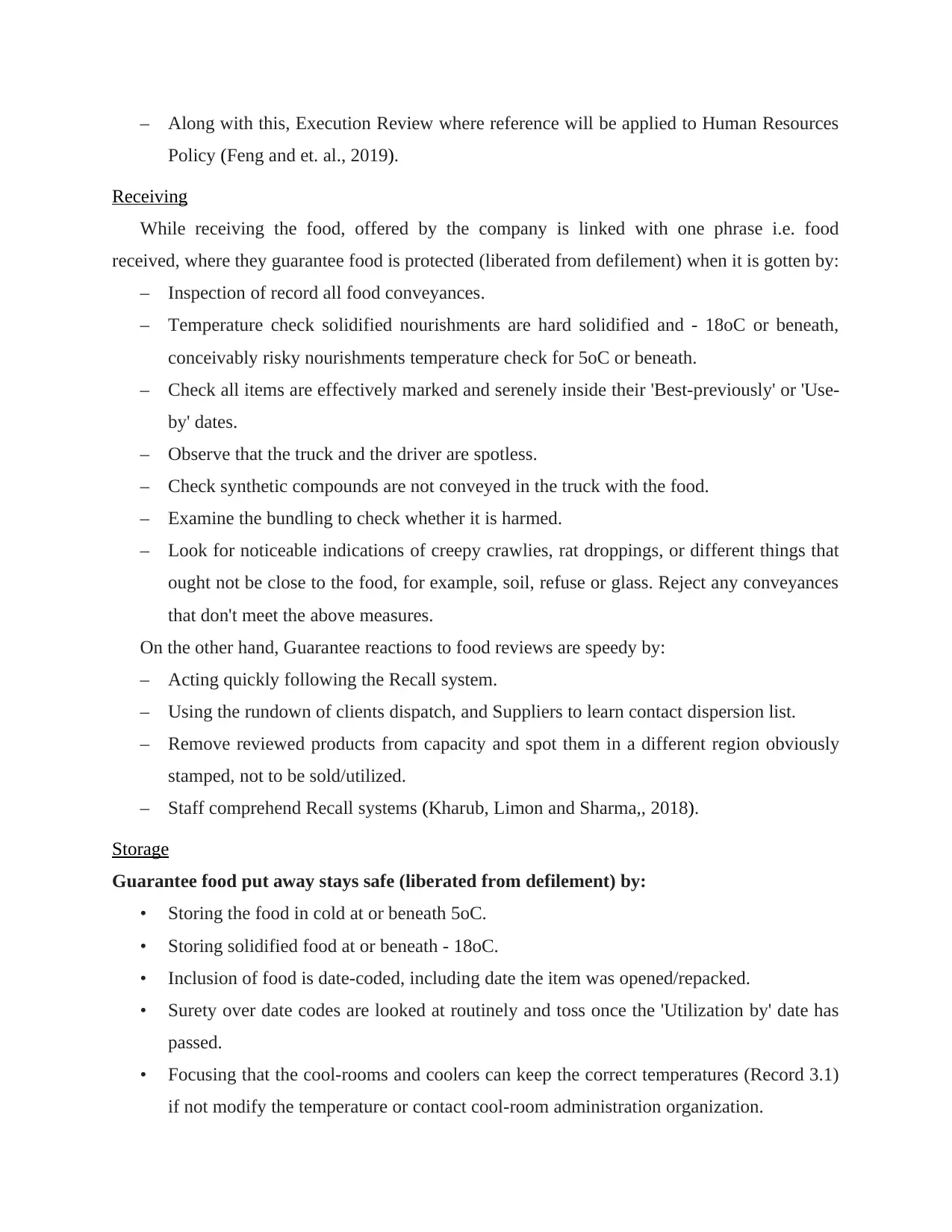
– Along with this, Execution Review where reference will be applied to Human Resources
Policy (Feng and et. al., 2019).
Receiving
While receiving the food, offered by the company is linked with one phrase i.e. food
received, where they guarantee food is protected (liberated from defilement) when it is gotten by:
– Inspection of record all food conveyances.
– Temperature check solidified nourishments are hard solidified and - 18oC or beneath,
conceivably risky nourishments temperature check for 5oC or beneath.
– Check all items are effectively marked and serenely inside their 'Best-previously' or 'Use-
by' dates.
– Observe that the truck and the driver are spotless.
– Check synthetic compounds are not conveyed in the truck with the food.
– Examine the bundling to check whether it is harmed.
– Look for noticeable indications of creepy crawlies, rat droppings, or different things that
ought not be close to the food, for example, soil, refuse or glass. Reject any conveyances
that don't meet the above measures.
On the other hand, Guarantee reactions to food reviews are speedy by:
– Acting quickly following the Recall system.
– Using the rundown of clients dispatch, and Suppliers to learn contact dispersion list.
– Remove reviewed products from capacity and spot them in a different region obviously
stamped, not to be sold/utilized.
– Staff comprehend Recall systems (Kharub, Limon and Sharma,, 2018).
Storage
Guarantee food put away stays safe (liberated from defilement) by:
• Storing the food in cold at or beneath 5oC.
• Storing solidified food at or beneath - 18oC.
• Inclusion of food is date-coded, including date the item was opened/repacked.
• Surety over date codes are looked at routinely and toss once the 'Utilization by' date has
passed.
• Focusing that the cool-rooms and coolers can keep the correct temperatures (Record 3.1)
if not modify the temperature or contact cool-room administration organization.
Policy (Feng and et. al., 2019).
Receiving
While receiving the food, offered by the company is linked with one phrase i.e. food
received, where they guarantee food is protected (liberated from defilement) when it is gotten by:
– Inspection of record all food conveyances.
– Temperature check solidified nourishments are hard solidified and - 18oC or beneath,
conceivably risky nourishments temperature check for 5oC or beneath.
– Check all items are effectively marked and serenely inside their 'Best-previously' or 'Use-
by' dates.
– Observe that the truck and the driver are spotless.
– Check synthetic compounds are not conveyed in the truck with the food.
– Examine the bundling to check whether it is harmed.
– Look for noticeable indications of creepy crawlies, rat droppings, or different things that
ought not be close to the food, for example, soil, refuse or glass. Reject any conveyances
that don't meet the above measures.
On the other hand, Guarantee reactions to food reviews are speedy by:
– Acting quickly following the Recall system.
– Using the rundown of clients dispatch, and Suppliers to learn contact dispersion list.
– Remove reviewed products from capacity and spot them in a different region obviously
stamped, not to be sold/utilized.
– Staff comprehend Recall systems (Kharub, Limon and Sharma,, 2018).
Storage
Guarantee food put away stays safe (liberated from defilement) by:
• Storing the food in cold at or beneath 5oC.
• Storing solidified food at or beneath - 18oC.
• Inclusion of food is date-coded, including date the item was opened/repacked.
• Surety over date codes are looked at routinely and toss once the 'Utilization by' date has
passed.
• Focusing that the cool-rooms and coolers can keep the correct temperatures (Record 3.1)
if not modify the temperature or contact cool-room administration organization.
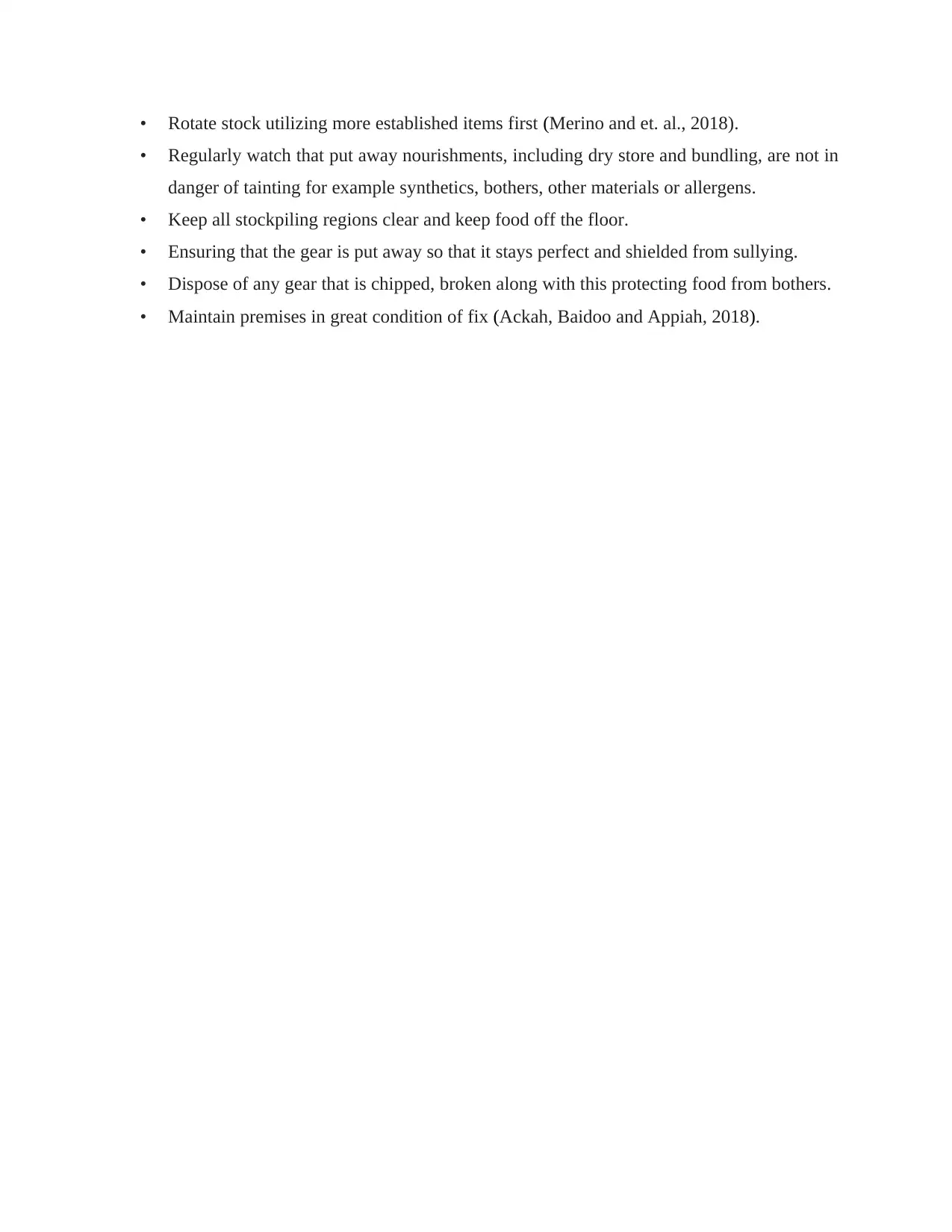
• Rotate stock utilizing more established items first (Merino and et. al., 2018).
• Regularly watch that put away nourishments, including dry store and bundling, are not in
danger of tainting for example synthetics, bothers, other materials or allergens.
• Keep all stockpiling regions clear and keep food off the floor.
• Ensuring that the gear is put away so that it stays perfect and shielded from sullying.
• Dispose of any gear that is chipped, broken along with this protecting food from bothers.
• Maintain premises in great condition of fix (Ackah, Baidoo and Appiah, 2018).
• Regularly watch that put away nourishments, including dry store and bundling, are not in
danger of tainting for example synthetics, bothers, other materials or allergens.
• Keep all stockpiling regions clear and keep food off the floor.
• Ensuring that the gear is put away so that it stays perfect and shielded from sullying.
• Dispose of any gear that is chipped, broken along with this protecting food from bothers.
• Maintain premises in great condition of fix (Ackah, Baidoo and Appiah, 2018).
⊘ This is a preview!⊘
Do you want full access?
Subscribe today to unlock all pages.

Trusted by 1+ million students worldwide
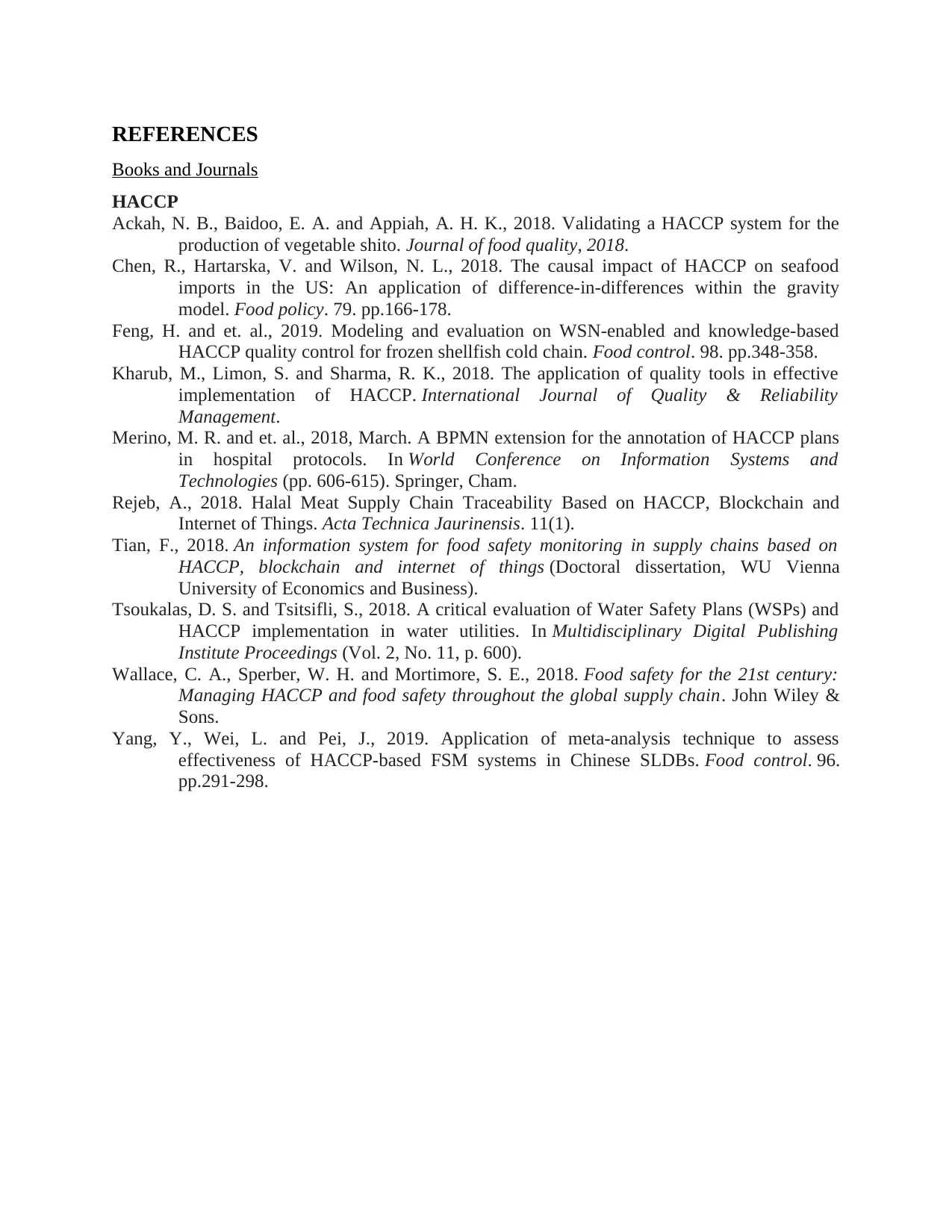
REFERENCES
Books and Journals
HACCP
Ackah, N. B., Baidoo, E. A. and Appiah, A. H. K., 2018. Validating a HACCP system for the
production of vegetable shito. Journal of food quality, 2018.
Chen, R., Hartarska, V. and Wilson, N. L., 2018. The causal impact of HACCP on seafood
imports in the US: An application of difference-in-differences within the gravity
model. Food policy. 79. pp.166-178.
Feng, H. and et. al., 2019. Modeling and evaluation on WSN-enabled and knowledge-based
HACCP quality control for frozen shellfish cold chain. Food control. 98. pp.348-358.
Kharub, M., Limon, S. and Sharma, R. K., 2018. The application of quality tools in effective
implementation of HACCP. International Journal of Quality & Reliability
Management.
Merino, M. R. and et. al., 2018, March. A BPMN extension for the annotation of HACCP plans
in hospital protocols. In World Conference on Information Systems and
Technologies (pp. 606-615). Springer, Cham.
Rejeb, A., 2018. Halal Meat Supply Chain Traceability Based on HACCP, Blockchain and
Internet of Things. Acta Technica Jaurinensis. 11(1).
Tian, F., 2018. An information system for food safety monitoring in supply chains based on
HACCP, blockchain and internet of things (Doctoral dissertation, WU Vienna
University of Economics and Business).
Tsoukalas, D. S. and Tsitsifli, S., 2018. A critical evaluation of Water Safety Plans (WSPs) and
HACCP implementation in water utilities. In Multidisciplinary Digital Publishing
Institute Proceedings (Vol. 2, No. 11, p. 600).
Wallace, C. A., Sperber, W. H. and Mortimore, S. E., 2018. Food safety for the 21st century:
Managing HACCP and food safety throughout the global supply chain. John Wiley &
Sons.
Yang, Y., Wei, L. and Pei, J., 2019. Application of meta-analysis technique to assess
effectiveness of HACCP-based FSM systems in Chinese SLDBs. Food control. 96.
pp.291-298.
Books and Journals
HACCP
Ackah, N. B., Baidoo, E. A. and Appiah, A. H. K., 2018. Validating a HACCP system for the
production of vegetable shito. Journal of food quality, 2018.
Chen, R., Hartarska, V. and Wilson, N. L., 2018. The causal impact of HACCP on seafood
imports in the US: An application of difference-in-differences within the gravity
model. Food policy. 79. pp.166-178.
Feng, H. and et. al., 2019. Modeling and evaluation on WSN-enabled and knowledge-based
HACCP quality control for frozen shellfish cold chain. Food control. 98. pp.348-358.
Kharub, M., Limon, S. and Sharma, R. K., 2018. The application of quality tools in effective
implementation of HACCP. International Journal of Quality & Reliability
Management.
Merino, M. R. and et. al., 2018, March. A BPMN extension for the annotation of HACCP plans
in hospital protocols. In World Conference on Information Systems and
Technologies (pp. 606-615). Springer, Cham.
Rejeb, A., 2018. Halal Meat Supply Chain Traceability Based on HACCP, Blockchain and
Internet of Things. Acta Technica Jaurinensis. 11(1).
Tian, F., 2018. An information system for food safety monitoring in supply chains based on
HACCP, blockchain and internet of things (Doctoral dissertation, WU Vienna
University of Economics and Business).
Tsoukalas, D. S. and Tsitsifli, S., 2018. A critical evaluation of Water Safety Plans (WSPs) and
HACCP implementation in water utilities. In Multidisciplinary Digital Publishing
Institute Proceedings (Vol. 2, No. 11, p. 600).
Wallace, C. A., Sperber, W. H. and Mortimore, S. E., 2018. Food safety for the 21st century:
Managing HACCP and food safety throughout the global supply chain. John Wiley &
Sons.
Yang, Y., Wei, L. and Pei, J., 2019. Application of meta-analysis technique to assess
effectiveness of HACCP-based FSM systems in Chinese SLDBs. Food control. 96.
pp.291-298.
1 out of 10
Your All-in-One AI-Powered Toolkit for Academic Success.
+13062052269
info@desklib.com
Available 24*7 on WhatsApp / Email
![[object Object]](/_next/static/media/star-bottom.7253800d.svg)
Unlock your academic potential
Copyright © 2020–2025 A2Z Services. All Rights Reserved. Developed and managed by ZUCOL.